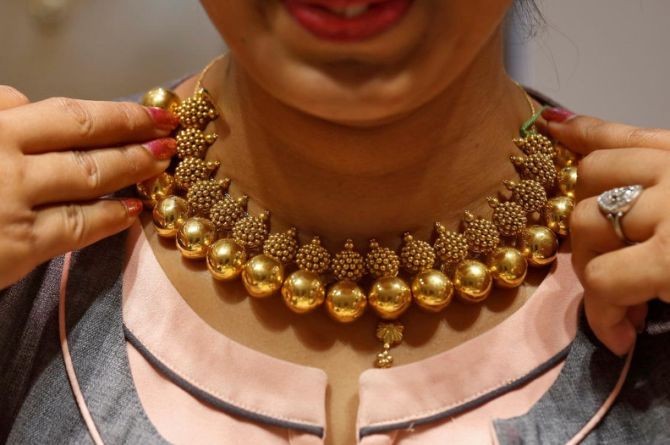 | « Back to article | Print this article |
'Lack of a coherent policy and the unwillingness of Indian jewellers to reform and have products to suit millennials, are tarnishing the industry', says Rajesh Bhayani.

In 2010, India’s gold demand for jewellery and investment was 1,001 tonnes.
China’s was 676 tonnes. By 2018, China was consuming 1,058 tonnes whereas India’s demand had dropped to 760 tonnes (and is likely to fall further in 2019), according to World Gold Council data.
This dramatic reversal in the gold economies of Asia’s two largest countries isn’t restricted to demand patterns.
China is also the world’s largest gold producer.
And India, despite being a major consumer, is unable to influence global prices.
An Indian-indexed gold price, a dream one and half decades ago, is still a dream.
Much of this asymmetry has to do with the manner in which the jewellery industries in both countries have shaped up.
In the past decade, India’s annual jewellery demand has averaged 609 tonnes against China’s 737 tonnes.
Given the near-constant demand from India’s matrimonial market, why has China overtaken India?
Somasundaram PR, managing director, India, World Gold Council, says, “China’s demand has been supported by conducive policies and infrastructure, and a significant drive towards innovation by the trade.
"This can happen in India, without impacting the current account deficit, but an effective policy framework is necessary."
China’s biggest infrastructure decision was setting up the Shanghai Gold Exchange in 2002.
All gold, including the 400 tonnes a year that is mined and produced locally, has to be routed through it.
In 2014, this trading system was expanded when the Shanghai International Gold Exchange was set up in the free trade zone, creating a global ecosystem for the industry.
Four years ago, Department of Economic Affairs Secretary Shaktikanta Das (now Reserve Bank of India governor) proposed a gold exchange.
Later, several meetings took place in the finance ministry for a NITI Aayog submitted a report on in in February 2018. Nothing has happened since.
Jewellers also focused on innovations to grow demand. Chirag Sheth, senior research consultant, South Asia, Metals Focus, an independent precious metals consultancy, said, “China has really scored over Indian jewellers with innovation and product lines for the young.
"India’s jewellery market remains largely confined to the bridal market.”
One such Chinese innovation is “mirror gold”, which has a smooth, reflective surface and is a hit with younger consumers.
China has also developed technology that hardens gold, a soft metal that requires the addition of alloys for jewellery making, and enables jewellers to make jewellery with high purity gold. India doesn’t produce gold ornaments of even 999 (three 9s) or 995 (two 9s) purity.
The most successful innovation is in the 3D printed “hard gold” market, which caters to consumer appetite for smaller, more trendy pieces -- typically weighing 1-2 grammes.
Indian jewellers scarcely have products to suit millennials.
Few young Indian women today wear saris and the cohorts joining the white-collar workforce prefer lighter jewellery, one reason platinum and silver jewellery imports are making inroads in India.
At least part of the reason for Indian jewellers’ slow response is that, jewellery demand has been resilient despite stiffer compliance measures, so the impulse for change is weak.
Though India is the largest gold importer, the country lacks a programme to support gold mining.
The 11th Plan document (2007-12) noted that it was possible to bring 17 new gold mines into production.
The government set a goal to reach annual production of 100 tonnes gold per annum by 2025 against 2-3 tonnes currently.
A working group in the ministry of mines put the total reserve base (as on April 1, 2011) at 658 tonnes spread over 13 states.
The economic slowdown is one reason the gold policy has not been a priority for the government.
Some moves at self-regulation are taking place at the association level but a consensus among the hundreds and thousands of jewellers has proved elusive -- because they are uninterested in reform.
Most jewellers are happy if mandatory hallmarking were delayed and to continue with cash transactions and bullion traders prefer to continue dealing offline.
Therefore, gold smuggling flourishes -- the value of smuggled gold in this year of weak demand is an estimated $5 billion-plus.
It is only now that the $75 billion Indian jewellery business has acquired a modicum of transparency, but organised and online jewellers account for just a third of the business.
Stiff regulations against taking deposits from customers have hindered few jewellers who continue to leverage personal trust equations with customers.
Some of them take the money and disappear.
They are unlikely to support regulation and transparency.
Jewellers persist with deposit-taking because banks shy away from lending to them.
So customer deposits remains a multi-billion dollar channel for funding. Big customers, whether they hold gold legally or otherwise, lend to jewellers in the informal market where few banks are active.
There are two types of bank financing.
One is lending physical gold known (gold metal loan) and the other is providing collateral finance and working capital.
On an outstanding basis annual gold metal loans are only around 120 tonnes or a fifth of jewellery demand.
Says Somasundaram, “There is no agreement on even fundamental issues such as generating trust or fostering innovation or making a strong case for gold.
"There is overwhelming focus on duty reduction (on imports) which is self-inhibiting.”
This is ironic because a coherent and transparent market would enable Indian jewellers to make the great leap forward to catch up with China in an industry that was once a traditional strength.
Photograph: Francis Mascarenhas/Reuters.